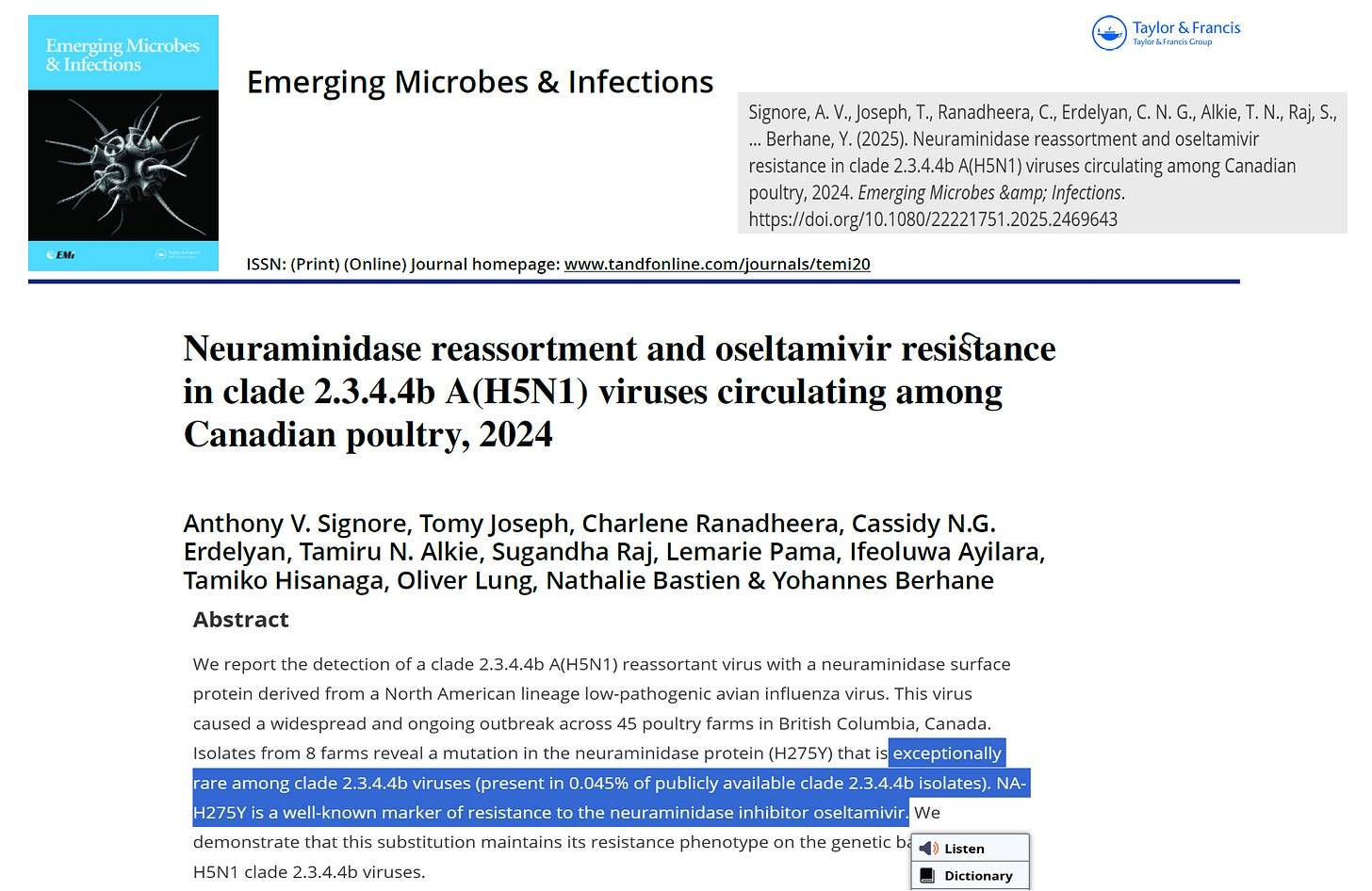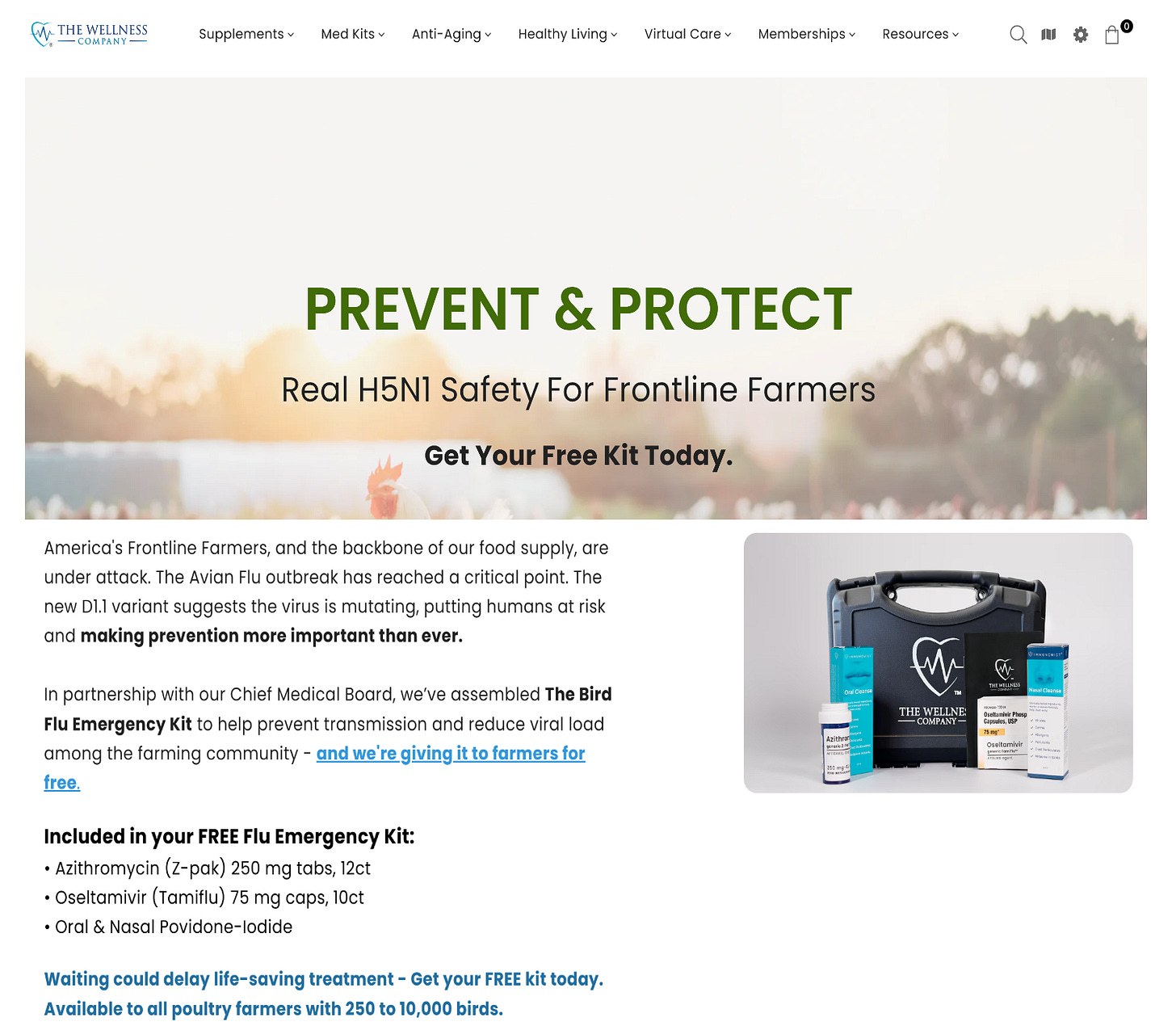Canadian Authorities Report Tamiflu Resistance Very Low in H5N1 Isolates
Good News for Early Treatment of High Risk Cases
By Peter A. McCullough, MD, MPH
The mainstay of early treatment of human bird flu has been the use of generic antiviral therapy. Oseltamivir, also known as Tamiflu, works by inhibiting the neuraminidase enzyme on the surface of influenza viruses, preventing the release of new viral particles from infected cells, thereby hindering the spread of the virus within the body and limiting the severity of infection; essentially, it acts as a "neuraminidase inhibitor" by blocking the virus's ability to replicate and spread further.

Signore et al, from the National Centre for Foreign Animal Disease, Canadian Food Inspection Agency, Winnipeg, Canada, has reported that resistance to tamiflu was found in present in 0.045% of publicly available clade 2.3.4.4b H5N1 isolates. This is good news for farmers who have taken steps to protect themselves and their workers with the new Prevent and Protect Program from The Wellness Company. Free kits are available to small farmers with this new program that includes a course of oral oseltamivir. Kits should be used in cases of suspected human bird flu even before the results of H5N1 PCR testing are back.
Please subscribe to FOCAL POINTS as a paying ($5 monthly) or founder member so we can continue to bring you the truth.
Peter A. McCullough, MD, MPH
President, Chief Scientific Officer, The Wellness Company






Tamiflu pubmed Psychiatic Issues https://pmc.ncbi.nlm.nih.gov/articles/PMC4375804/
Mark Twain quote: "Part of the secret of success in life is to eat what you like and let the food fight it out inside."
With what is currently known about the biochemistry of eicosanoid and endocannabinoid producton, there is, indeed, molecular competition for positions in cell membranes. For example, Norwegian animal science researchers have noted that "Because arachidonic acid (AA) competes with EPA and DHA as well as with LA, ALA and oleic acid for incorporation in membrane lipids at the same positions, all these fatty acids are important for controlling the AA concentration in membrane lipids, which in turn determines how much AA can be liberated and become available for prostaglandin biosynthesis following phospholipase activation." This is important because high concentrations of arachidonic acid in cell membranes promotes prostanoid overproduction and excessive endocannabinoid production."
The Norwegians also advised that "the best strategy for dampening prostanoid overproduction in disease situations would be to reduce the intake of AA, or reduce the intake of AA at the same time as the total intake of competing fatty acids (including oleic acid) is enhanced, rather than enhancing intakes of EPA and DHA only." https://pmc.ncbi.nlm.nih.gov/articles/PMC2875212/
Endocannabinoid overproduction: "Experimental and clinical intervention studies suggest that omega-6 and omega-3 fatty acids have opposing physiological and metabolic properties and elicit divergent effects on body fat gain through mechanisms of adipogenesis, browning of adipose tissue, lipid homeostasis, systemic inflammation and an increase in the tone of the endocannabinoid system. Overweight and obese individuals have higher levels of the arachidonic acid (AA) derived endocannabinoid N-arachidonoylethanolamine (AEA) and 2-arachidonoylglycerol (2-AG) and an altered pattern of receptor expression. Since endocannabinoids are products of dietary fats, modification of the omega-6 and omega-3 fatty acid intake modulates the endocannabinoids, with eicosapentaenoic acid (EPA) and docosahexaenoic acid (DHA) displacing AA from cell membranes, reducing AEA and 2-AG production, resulting in decrease in appetite and food intake leading to weight loss." https://www.ocl-journal.org/articles/ocl/full_html/2020/01/ocl190046s/ocl190046s.html
Typically, researchers enhance intakes of ALA, EPA, DHA, and Oleic acid without reducing arachidonic acid intake. In sufficient quantities, all of these fatty acids can improve insulin sensitivity especially if they happen to displace saturated fatty acids in the diet. Ironically, as noted above, inoleic acid also displaces arachidonic acid from cell membranes, but not without consequence. (web search - high linoleic acid intake pain conditions)
Excerpt from Introduction to the 'Risk Stratification' article. "Positron emission tomography data have revealed a shift from free fatty acid metabolism to glucose metabolism in the hearts of the majority of individuals who have received a COVID-19 vaccine. The positron emission tomography pattern resembles global ischemia. This could be due to vaccine Spike protein hemagglutination in myocardial capillaries or cellular changes in mitochondrial respiration and substrate metabolism."
That shift to glucose metabolism in the heart smacks of insulin resistance. (web search - prostanoid overproduction insulin resistance)